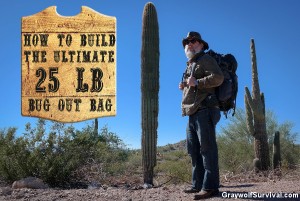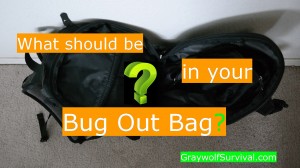 Water is one of the most critical resources you need to have with you to survive any situation, but just how much should you carry with you? As I mentioned previously in How much gear should you put in your bug out bag?, it all comes down to your planning and training.
Water is one of the most critical resources you need to have with you to survive any situation, but just how much should you carry with you? As I mentioned previously in How much gear should you put in your bug out bag?, it all comes down to your planning and training.
If you’re one of my previous readers, you probably know by now that I like to dig into a topic and not just throw out some softball, 400-word article about something. I want you to actually understand it from top to bottom and then you can adapt that knowledge to whatever situation you find yourself in. This is no different.
I live in the desert and have lived downrange in the some of the hottest environments imaginable. I’ve sat many hours in the middle of summer on flightlines in Iraq in full body armor while a C17 or C130 sits running its engines waiting for clearance and I’ve hiked combat missions through the deserts of Afghanistan with a full back, body armor, two weapons and full combat load. None of that compared with the absolutely insanely stupid heat of Djibouti. In all of those instances, I could have easily suffered heat exhaustion or heat stroke if I wouldn’t have had a sufficient supply of water available and battle buddies who are trained in recognizing and treating heat-related injuries. Water is a big deal for me.
It’s really amazing to me that with the hundreds and thousands of hours of video games I’ve wasted invested in playing over the years, I don’t remember a single game that required that you drink or purify water as you go or suffer the consequences – even the military combat-centric ones. WTF?
Drinking water is ingrained in the brains of every Soldier. I first joined the military back before the Berlin Wall fell and was fighting in Afghanistan last year. In all the years between, with all the garrison and school training, it still haunts me to hear the melodic DRINK waTER! of some asshole NCO as we stopped ruck marching to nowhere just so we could march back. Not to say that checking on your Joes for water and ammo regularly is a bad thing. Much better though than back in previous wars when the Army, in its infinite wisdom, thought that you could train yourself to get used to being dehydrated and would purposely not let people drink during some training exercises. Guess what – you can’t.
Obviously, I keep a good deal of water in my home, in the trunk of my car, in every empty spot in my freezer, in my shed (well, it’s an enclosed car trailer with a flat tire, so it’s now a shed). I even keep a gallon on my Harley at all times. The problem is, I can’t trust that these little caches of water will always be available. What happens if I’m stuck out driving through the desert overnight because my car broke down or I somehow get stranded until morning during a search and rescue operation for the Sheriff’s Office?
What happens if SHTF and I’m not home or can’t use my car? Obviously, the answer is to have water in my go bag, which I bring everywhere. This is all about how much water you should probably have in your bug out bag in case you have to go it on foot to get from where you think you’ll be to where you think you’ll want to get to.
How much water does a person need each day?
If you want a quick answer, check out this Human Water Requirement Calculator. According to it, a 200 pound guy exercising for an hour in a moderate environment needs 86 ounces of water per day without doing anything and 120 ounces if he exercises for an hour. That tells me each hour of exercise (according to this calculation) requires 34 ounces of extra water. Obviously this depends on how much exercise, how in-shape you are, and doesn’t take into consideration any exhaustion. If we assume you walk at 2 miles per hour, a 16-mile hike will take around 8 hours and 358 ounces of water (86 + (120-86)*8)). 358 ounces is about 2.8 gallons. I really don’t think that’s right. Personally, I’d put it at about a gallon and a half for the day as a SWAG and then adjust from there.
Each person is different. Each activity you do will affect how much you sweat. What you eat or drink can have a diuretic effect and make you pee more. The humidity and temperature as well. What you’re wearing will also affect your core temperature as well. We can speak about some general guidelines though but it’s a bit more complicated than that.
Instead of thinking about how much water you need per day, in a bug out situation, you should be thinking about how much you need per mile after you’ve left your known water sources, at least as far as when it comes to what goes in your bug out bag for bugging out to some location.
Ultralight camping
I ended up putting this part in my last article after writing it here because it fit better there but it’s directly pertinent to this topic so instead of rewriting it, I’m going to mess up my SEO a bit and keep it here as-is. ‘Cause I’m lazy like that sometimes. I did put it in italics though.
I’ve found that hikers are a much more reliable source when it comes to bug out resources for things like this than typical military sources are – especially camping hikers. They bring what they need with them and find everything else along the way. If you want to expand your prepper knowledge and skills beyond where they are right now, find yourself a hiking group and a camping group to go out with on occasion. Then when you think you really know your stuff, find an ultralight backpacking group and get ready to get schooled.
Ultralight camping was made popular by a guy named Ray Mears in a book he wrote in 1992 called PCT Hiker’s Handbook, which has been updated and is now titled Beyond Backpacking: Ray Jardine’s Guide to Lightweight Hiking. That pretty much revolutionized current thinking and started an entire new genre in outdoor activities.
You may have heard of Ray Mears but have you heard of Emma “Grandma” Gatewood? In 1955, she was the first woman to hike the 2100+ mile Appalachian trail – and did it in one season – at age 67! What’s also amazing is that she did it while wearing Keds sneakers and carrying an army blanket, a raincoat, and a plastic shower curtain which she carried in a homemade bag slung over one shoulder. Think she’d have a problem making it to her bug out location?
What was her philosophy on what to take?
“Make a rain cape, and an over the shoulder sling bag, and buy a sturdy pair of Keds tennis shoes. Stop at local groceries and pick up Vienna sausages… most everything else to eat you can find beside the trail”
If you want to read the story, check out Grandma Gatewood’s Walk: The Inspiring Story of the Woman Who Saved the Appalachian Trail.
So how much water should you be carrying in your bug out bag?
The plain and simple truth is that you can’t carry an unlimited supply of water. You have a limited amount of space that you can pack on your body and a limited amount of weight that you can carry, especially if you’re going to carry it farther than to your car and back. Forget about it in an emergency situation or while getting shot at. In addition, water is not the only thing that you need to survive in a lot of situations and every gallon of it that you take will cost you about 8.34 pounds (plus whatever you’re carrying it in) and about 231 cubic inches of space. Check out this handy little online water calculator for conversions to get volume and weight for different amounts of water.
So if you haven’t spent months working up to the weight, distance, and terrain required of whatever your bug out plan is, your bag is gonna be pretty light. If it’s not light when you start, it’ll be light once you get going and figure out that you can’t carry what you thought you could carry. That means that you’re not going to be able to carry a lot of water. Plus, as we’ve seen from the masters above, you really don’t need that much anyway.
How much you carry is a balance between ensuring you have enough water to get there and not having too much. Too much not only increases the amount of work you have to do (calories burned) and the likelihood of getting hurt, it cuts down on other things that you can carry. That’s called Opportunity Cost.
Basically, if you can carry 20 pounds of stuff in your bag and you put in a gallon, you can still carry 11.66 pounds of other stuff. If you decided to play it safe and put in another gallon, you’d only be left with a hair over 3 pounds. What would you have to lose to carry that extra gallon? The ability to make fire? Shelter?
The key is training and planning
Training
If you somehow had the knowledge to pull water out of the ground from anywhere with just what you find laying around, you wouldn’t have to carry water at all. We can’t do that – but almost.
If you know how to read the land, it can tell you where there’s water. The more water that you can find and use in an area, the less you have to carry.
Water always follows the easiest path back to the sea. In most cases, that means it goes from uphill to downhill using any valleys or depressions it can along the way. After a while, those valleys and depressions may get deeper from years and centuries of water eating away at it. These areas will sometimes grow different plants than those that can’t get that water.
Certain plants require a lot of water to survive. If you see a clump of them somewhere, it may be possible to get to the same water source they’re using.
Drinking unsafe water can be a really bad thing. If you know how to avoid the bad water – or make bad water into good water by using something like a water still, you now have water available that you didn’t previously.
Basically, by learning how to find water, and how to make that water safe, you increase the odds of you finding water and the frequency of those places along the way.
By far, the best way to learn how to find water, filter water, and do everything else to survive in a particular area is to find an expert in survival in that area and learn from them. They’ll know secrets that have sometimes been handed down for generations and that information is specific to that area.
A lot of that information will translate quite well to other areas of operation because it’ll be based on basic principles. With experience, you can translate those principles to the environment that you find yourself in. To really do that requires practice. What I’m saying is that in addition to learning from an expert, teach yourself by doing it yourself. When’s the last time you went camping with just your bug out bag? If you really want to know how much water you’d need for a route – walk the freaking route. If you do it before you need to, you can have water and whatever else you need back in a parking lot somewhere or just do it in phases to get a good idea.
By far, the easiest way to learn is to read from the experts. Just FYI: most websites out there suck so be careful. There’s a lot of ‘common knowledge’ out there that gets passed along from person to person because it sounds right, but it’s not. Take this for example:
That has over 16 million hits as of today and I’ve seen countless people share it all across facebook. It’s pure shit.
Old-school knowledge is great for that because it’s stood the test of time and is ‘evergreen’ knowledge. Books like How to Stay Alive in the Woods: A Complete Guide to Food, Shelter, and Self-Preservation That Makes Starvation in the Wilderness Next to Impossible are exactly that kind of book. It may not be as famous or as new as the SAS Survival Handbook
but I bet it has some great tidbits in it that you’ve never heard of.
Planning
How much you need is going to depend on all the things we talked about above. Obviously, if you’re planning for a just-in-case SHTF scenario, you may not have all the answers. In this case, look at the most likely scenarios and the worst-case scenarios and make a guess.
I’m not really a fan of guessing though. I’d rather have a plan and then let my training kick in when my planning goes South.
If you’re planning on bugging out, I’d hope you have a bug out location that you’re heading to. If not, stay home and bug in. Unless your house burns down or gets forcibly taken from you, you’re almost always safer to stay put until you come up with a plan. Hopefully you plan your bug out route to your bug out location in advance so you can scout out the area and see what’s available and what you’ll need.
Let’s say you’re a good little prepper or “family emergency coordinator” (as I’m calling it at the moment but it sounds a bit like someone who coordinates family emergencies so I need a better term), and you’ve made a route. You’ve done your due diligence and scouted the route and researched the typical weather patterns, threats, blah, blah, blah. Among all that stuff, you’d better be looking at water.
Along your most likely route, back up route(s), and in the general area in case all your routes are messed up and you can’t follow any of them, what’s the water situation? Is it a swamp? Is it mostly desert? Is it a wooded area with frequent small streams and small ponds? Is it an urban area that you have to maintain a low profile? All the above?
Do you have the training to get drinkable water in those areas? Did you plan ahead to bring something like the Sawyer Mini water filter that I carry to drink water without having to set up a fire or evaporate water every stop?
At each leg and general area of your route, you should plan on where you’ll find water. It should be marked out on your map or at least in your head. From each of those locations, how far is it to the next body of water? If it’s too far, you’ll need to redo your route. What if the next area is dry or impassible – how far until the next one?
If you can’t possibly carry that much water, you need to either redo your route or plan, place, and document some caches along the way that include water.
Get intimate with your water usage
You need to get a feel for how much water you use under what conditions. The only way to do this is to do it. As you’re jogging, hiking, whatever, start weighing yourself before you go and when you get back as well as keep track of how much water you drink. It’s not a perfect system because how well you’re hydrated before you start and when you get back will affect things but try this:
- Hydrate well before you head out.
- Weigh yourself.
- Go do what you’re gonna do but keep track of how much water you drink along the way.
- Weigh yourself when you get back.
- If you weigh less than when you left, convert that weight into water volume using 8.34 gals per pound (so two pounds would be just under a quart low).
- If you weigh more (not likely), just do the opposite.
- Add that water weight loss to the water you drank and you have your water requirement for that activity
To put it simply:
If you don’t know where you’re going or what you’ll be facing then just put in as much water as you can carry and make sure you have a backup filtration system or two. I’d put in at least a half gallon, no matter what and drink as much as you can before you head out. I prefer water bottles to bags because they’re easier to pack, easier to reuse and can be used to boil water later etc.
If you do know where you’re going, study the ground and learn where the water is and plan your route accordingly to hit those spots.
If you had a route that had a known water source every 5 miles that you could drink (for example), you’d have to have enough water to let you go at least 5 miles. Keep in mind that you might get lost or underestimate how much water you use. If that water isn’t something like a north-south river that can’t be missed, then you might walk right by it. You might also be carrying more weight than you expected. The more planning you do, the less variables you’ll have to add as a fudge factor and the less you’ll have to carry.
If you plan ahead, you’ll know how to find the water points on your route and don’t have to worry as much about putting extra water that you probably won’t use. Make sure you know how to recognize those locations at the ground level. The map is not the territory.
If you learn how to find water that isn’t readily available, you won’t have to walk 5 miles to get it and can still find it if you get lost. The more training and learning you do, the more water will be available to you and the less you’ll have to carry.
So based on your research for your routes or circumstances, your plans and what training you have, you should have an idea about how much water you’d need to get from one point to the next along your route.
That, plus some wiggle room is how much you need to carry.
If you want more really good ideas for how to lighten your bug out bag load, head to a bookstore and check out these books. They have a lot of useful information you won’t find on any prepper site:
- Trail Life: Ray Jardine’s Lightweight Backpacking
- Ultralight Backpackin’ Tips: 153 Amazing & Inexpensive Tips for Extremely Lightweight Camping
- Trail Tested: A Thru-Hiker’s Guide to Ultralight Hiking and Backpacking
- Lighten Up!: A Complete Handbook for Light and Ultralight Backpacking (Falcon Guide)







Just wanted to throw Nalgene out there as the water bottle of choice. Light weight, virtually indestructible, wide-mouthed so you can clean them easily, transparent so you can see how gross they are, and a lot of water filters that are designed to fit onto water bottles are fitted for Nalgenes (note, however, that most of these are more like Brita filters and insufficient for eliminating pathogens).
Also, unlike bags, they don’t bust and you can conveniently put dehydrated foods in them to soak as you walk so they cook quicker and a lot of stuff you can even eat without cooking if you soak it long enough. You can also stick stuff in empty Nalgenes to keep it dry (tinder, hats/gloves/socks, documents, etc.) whereas most bottles don’t have wide enough mouths to do this conveniently. Almost every backpacker I know uses Nalgenes. Only downside is you can’t boil stuff in them cause they’ll melt and they are bulkier than bags though extremely light.
When I thru-hike I always carry two or three Nalgenes plus an empty dromedary bag that I can fill up if I feel like I might need the extra water on a particular stretch of trail.
Tea bags, juice mix like Tang or an electrolyte mix weigh basically nothing and are also a good thing to have because water purified on trail often still tastes like crap even though it’s safe and you will stay better hydrated if you can’t taste the funk. Plus the electrolytes are a good idea anyway for that much exertion.
(Also, for the record, I am not paid to shill for Nalgene or anything, I just like them)
You should still be able to boil water in a nalgene bottle. You just have to suspend it above the flame and make sure it has a sufficient amount of water in it. The water will keep the plastic temp down near 212.
I do keep a nalgene in my main pack but I find the small water bottles are a lot easier to pack in my go bag and for the rest of my main pack.
Huh, I had no idea you could boil stuff in them! I will have to try that.
Yeah, they are a bit bulky/awkward to pack but I compensate by packing other stuff inside the extras (I like to have several on trail but rarely fill them all, but then again I am really experienced at getting water/realizing when I need to carry extra so I often actually carry less than other hikers but have the capacity to carry more).
Preferably I keep stuff in them that I will have to unpack anyway when I stop for water/rest (like my Sawyer filter–thanks for that recommendation, by the way; it’s replaced my Lifestraw–and purification tabs/drops, energy bars/gorp, etc., or my clean/dry sleeping clothes).
Plus I use a backpacking pack that is pretty much designed to have a bunch of crud crammed in and attached to it in weird ways, so I’ve never really had a problem.
I think this is a good example of why it’s so important to actually use & live with your gear, rather than just buying “the best” or most popular product or going down a checklist–everybody has different things that get on their nerves or interfere with some other piece of their gear, or things that work really well for them or solve some idiosyncratic problem of theirs, and a lot of the time there’s no way to know until you live with it for a while
And of course it’s even worse when you’re stressed and exhausted. Gear issues that seem like minor annoyances when you’re setting out may lead to sobbing uncontrollably while praying for the bears to come eat you and the dozen melted Snickers bars you are munching on inside your sleeping bag after a 20 mile day in drizzling rain while a dude with creepy eyes and no boundaries keeps trying to become your “hiking buddy.” Ask me how I know. I can’t imagine how much worse it would be in combat or a truly life-threatening situation, so best to figure out what works for you before that happens.
It’s the same thing as this https://www.youtube.com/watch?v=vLa9mxrrrsc
The jury is still out on whether doing this will release chemicals in the water (almost every single site out there says it does but it sure smells like one of those things that everyone just automatically repeats it without actually checking hard facts from scientific tests because people will immediately jump in and scream DO NOT DO THIS but can’t ever seem to come up with any references other than another site that says the same thing. Just heresay until I find out otherwise.
If you have a metal cup, use it. If not, use a plastic one. I guarantee you, absolutely no matter what chemicals may or may not come out of the plastic, drinking unsterilized water is MUCH more dangerous than drinking sterilized water. Not drinking at all can be even worse.
Definitely agree. I have seen too many people get horribly ill from drinking contaminated water. Not pretty. I just assumed plastic would melt or deform under heat; thanks for letting me know otherwise. Always glad to have more options.
Great in-depth article as usual! Like you anytime I hear Drink and water used together I have an uncontrollable urge to scream “beat the heat!” or something a lil more smart arsed and less PG.
The one scenario you didn’t mention to plan for though is resources being seized, occupied, or even expended when you arrive during your bug out. While not as big an issue in more humid and wet area’s, here in the Southwest we could easily see wells, water holes, springs, seeps, rock catchments, tanks, and sand wells occupied by others during a SHTF scenario requiring us to bug out. Depending on why we are bugging out they could be hostile at worst with armed protectors (or bandits) and maybe just have drank that water resource dry at best. So you should always include the need to pass several “known” or obvious sites incase they are occupied, plan back up seeps or sand wells that you can dig but the average person won’t recognize as viable water supplies, or even in really arid environments have pre located hidden catches of water that you regularly visit (annually) to check on, update, and replace.
While the story of Grandma Gatewood is inspiring in showing how even in our elder years we can survive and achieve great distances on very little, we can’t count on resources being available to scavenge or gather along the way. The AP trail then vs now is completely different from what I’ve heard and gathering edibles can be difficult since there is so many hikers each year on the trail. While edible plants and water is still there, you often expend great deals of energy for each calorie harvested, often taking you off your planned route.
Phoenix, Tuscon and the surrounding low laying desert cities are great “case studies” IMO of bugout issues. You have really one maybe two safe directions to head and at least 50-100 miles of travel until you could reasonably expect a serious climate and resource change by moving up to higher mountain terrain, but even then because of the varieties of rain and snowfall water is still a sacred resource here in the southwest and food doesn’t grow as abundantly nor reliably as it does in other areas. Depending on the time of year you buggout you could have feast or famine depending if it is early spring, monsoon season, winter, or early summer or Fall. With the 3.5 million in Maricopa County (closer to 4 million now for the Greater Metro area of greater Phoenix, encompassing several counties) even if only a small percentage actually makes it to the trails (say 10%) you can quickly see even during “feast” times that wild land resources could quickly be expended.
Again that old military Axiom of the 7 P’s comes to play, Prior Proper Planning Prevents Piss Poor Performance, and having multiple routes to your BO location as well as planned and secure water and food resources that you can depend on is important for the event of a bugout from any large Metro area.
I just want too add to you, that there is a whole genre of games( survival games) where you DO need to drink water too survive , for example h1z1. Or dayz.